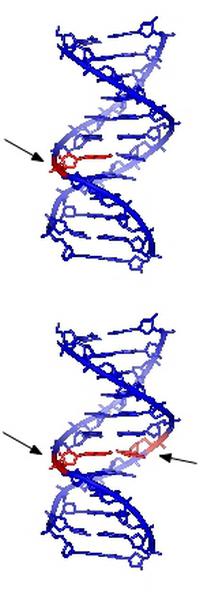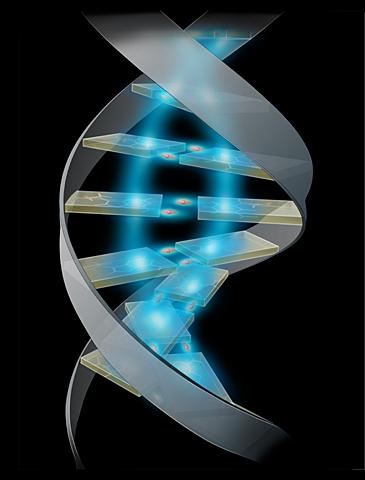Reparation is the ability of a living cell to fight various DNA damage. In the surrounding world, there are many factors that can cause irreversible changes in a living organism. In order to preserve its integrity, to avoid pathological and mutations incompatible with life, a system of independent recovery must exist. How is the integrity of the genetic material of the cell violated? Let's consider this question in more detail. We will also find out what the restorative mechanisms of the body exist and how they work.
DNA abnormalities
The deoxyribonucleic acid molecule can be broken both during biosynthesis and under the influence of harmful substances. Negative factors, in particular, include temperature or physical strength of various origins. If destruction occurs, the cell starts the repair process. So begins the restoration of the original structure of the DNA molecule. Special enzyme complexes present inside the cells are responsible for the repair. Some diseases are associated with the inability of individual cells to restore. The science of repair processes is biology. Within the framework of the discipline, a lot of experiments and experiments were carried out, thanks to which the recovery process becomes more understandable. It should be noted that the mechanisms of DNA repair are very interesting, as is the history of the discovery and study of this phenomenon. What factors contribute to the start of recovery? In order for the process to start, it is necessary that the tissue repair stimulator acts on the DNA. What is it, we will tell in more detail below.

Discovery story
This amazing phenomenon began to be studied by the American scientist Kölner. The first significant discovery in the study of repair was the phenomenon of photoreactivation. Kölner called this term the effect of reducing the harm caused by ultraviolet radiation during the subsequent treatment of damaged cells with a bright stream of light radiation from the visible spectrum.
"Light recovery"
Subsequently, Kölner’s research received its logical continuation in the works of American biologists Setlow, Rupert and some others. Thanks to the work of this group of scientists, it was reliably established that photoreactivation is a process that is triggered by a special substance - an enzyme that catalyzes the cleavage of thymine dimers. It turned out that they were formed during the experiments under the influence of ultraviolet radiation. At the same time, bright visible light triggered the action of the enzyme, which contributed to the splitting of dimers and the restoration of the initial state of damaged tissues. In this case, we are talking about the light variety of DNA recovery. We define this more clearly. It can be said that light repair is restoration under the influence of light of the original DNA structure after damage. However, this process is not the only one contributing to the elimination of damage.
Dark Recovery
Some time after the discovery of light, a dark repair was discovered. This phenomenon occurs without any exposure to light rays of the visible spectrum. This ability to recover was discovered during a study of the sensitivity of certain bacteria to ultraviolet rays and ionizing radiation. Dark DNA repair is the ability of cells to remove any pathogenic changes in deoxyribonucleic acid. But it should be said that this is no longer a photochemical process, in contrast to light recovery.
The mechanism of "dark" repair damage
Observations of bacteria showed that some time after the unicellular organism received a portion of ultraviolet radiation, as a result of which some sections of DNA were damaged, the cell regulates its internal processes in a certain way. As a result, the changed piece of DNA is simply cut off from the common chain. The resulting gaps are re-filled with the necessary material from amino acids. In other words, resynthesis of DNA is carried out. The discovery by scientists of a phenomenon such as dark tissue repair is another step in the study of the amazing protective abilities of the animal and human organism.
How is the repair system
The experiments that revealed the recovery mechanisms and the very existence of this ability were carried out using unicellular organisms. But repair processes are inherent in living cells of animals and humans. Some people suffer from pigmented xeroderma. This disease is caused by the lack of the ability of cells to synthesize damaged DNA. Xeroderma is inherited. What does the reparation system consist of? The four enzymes that the repair process rests on are DNA helicase, exonuclease, polymerase and ligase. The first of these compounds is capable of recognizing damage in the chain of a deoxyribonucleic acid molecule. He not only recognizes, but also cuts the chain in the right place to remove the changed segment of the molecule. The elimination itself is carried out using DNA exonuclease. Then, a new section of the deoxyribonucleic acid molecule is synthesized from amino acids in order to completely replace the damaged segment. Well, the final chord of this complex biological procedure is performed using the DNA ligase enzyme. He is responsible for attaching the synthesized region to the damaged molecule. After all four enzymes have done their job, the DNA molecule is completely updated and all the damage remains in the past. This is how the mechanisms inside a living cell work harmoniously.

Classification
At the moment, scientists distinguish the following types of repair systems. They are activated depending on various factors. These include:
- Reactivation
- Recombination recovery.
- Heteroduplex repair.
- Excision repair.
- Reunion of non-homologous ends of DNA molecules.
All unicellular organisms possess at least three enzyme systems. Each of them has the ability to carry out the recovery process. These systems include: direct, excisional and postreplicative. These three types of DNA repair have prokaryotes. As for eukaryotes, they have at their disposal additional mechanisms called Miss-mathe and Sos-repair. Biology has studied in detail all these types of self-healing of the genetic material of cells.
The structure of additional mechanisms
Direct repair is the least difficult way to get rid of pathological DNA changes. It is carried out by special enzymes. Thanks to them, the restoration of the structure of the DNA molecule occurs very quickly. As a rule, the process proceeds in one stage. One of the above enzymes is O6-methylguanine-DNA-methyltransferase. The excision repair system is a type of self-healing of deoxyribonucleic acid, which involves the excision of altered amino acids and their subsequent replacement with newly synthesized sites. This process is already ongoing in several stages. During post-replicative DNA repair, single chain gaps can form in the structure of this molecule. Then they close with the participation of the RecA protein. The post-replicative repair system is unique in that in its process there is no stage for recognizing pathogenic changes.
Who is responsible for the recovery mechanism
To date, scientists know that such a simple creature, like E. coli, has at least fifty genes that are directly responsible for repair. Each gene performs certain functions. These include: recognition, removal, synthesis, attachment, identification of the effects of ultraviolet radiation and so on. Unfortunately, any genes, including those that are responsible for the repair processes in the cell, undergo mutational changes. If this happens, then they trigger more frequent mutations in all cells of the body.
The danger of DNA damage
Every day, the DNA of our body’s cells is at risk of damage and pathological changes. This is facilitated by environmental factors such as ultraviolet radiation, food additives, chemicals, temperature changes, magnetic fields, numerous stresses that trigger certain processes in the body, and much more. If the DNA structure is broken, it can cause a severe mutation of the cell, and can lead to cancer in the future. That is why the body has a set of measures designed to deal with such damage. Even if the enzymes fail to restore the DNA to its original state, the repair system works to minimize damage.
Homologous recombination
Let's figure out what it is. Recombination is the exchange of genetic material during the breakdown and bonding of deoxyribonucleic acid molecules. In the event that gaps occur in the DNA, the process of homologous recombination begins. During it, fragments of two molecules are exchanged. Thanks to this, the original structure of deoxyribonucleic acid is precisely restored. In some cases, DNA can enter. Thanks to the recombination process, the integration of these two dissimilar elements is possible.
Recovery mechanism and body health
Reparation is a prerequisite for the normal functioning of the body. Undergoing daily and hourly threats of DNA damage and mutations, the multicellular structure adapts and survives. This happens, among other things, due to the established system of repair. Lack of normal restorative ability causes diseases, mutations and other deviations. These include various developmental pathologies, oncology, and even aging itself. Hereditary diseases due to repair disorders can lead to severe malignant tumors and other abnormalities of the body. Some diseases are now identified that are caused precisely by malfunctions of DNA repair systems. These are, for example, pathologies such as Cocaine's syndrome, xeroderma, non-polypous colon cancer, trichotiodystrophy, and some cancers.